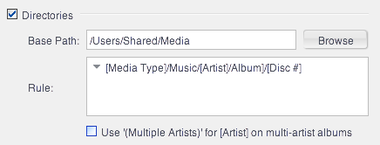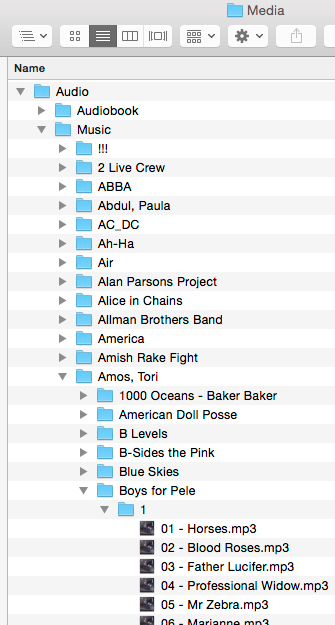Directories Template
- See also: Rename, Move, and Copy Files
The Directories Template is used to set the base path and directories used to store your files. You set a Base Path that will be used for all files selected in the tool (this would typically contain the disk letter or volume name), and then a Rule which auto-generates the directories used based on each file's metadata. The Directories Template does not consider the source directories, disk, or volume, and the selected files can come from a variety of source locations.
For example, you might want to consolidate files from a variety of source locations on disk into a common media folder, and then put each file in folders corresponding to their [Artist] property, with sub-folders for each [Album].
The Directories Template consists of two main components:
- Base Path: The portion of the destination path that will be identical for all files selected.
- Rule: The portion of the destination path that will be generated based on the metadata from each file.
Base Path
This is the "root" folder where Media Center will move or copy the files. This path will be identical for all files processed by the template. You can click the Browse button to choose from a disk location using the standard OS directory picker, or you can type a path into the text box. This portion of the path will be used verbatim, and any folders specified that do not exist will be created automatically.
Rule
This is the portion of the destination path that will be generated using the metadata from the files processed by the template. You can tell Media Center to insert file-specific properties by using the standard Library Field square bracket notation, such as [Artist], [Album], [Series], or [Genre]. To accomplish more advanced path generation, the rule may also contain Expression Language functions.
Example
The easiest way to understand how to use the Directories Template system is with an example. Suppose you have a set of music files you'd like to consolidate into the following filesystem location: /Users/Shared/Media.
Within this location, you'd like a folder structure with folders for the media type, artist, album, and disc number, like this:
To do this, you could use something like this:
- Base Path: /Users/Shared/Media
- Rule: [Media Type]/Music/[Artist]/[Album]/[Disc #]
So, if you'd selected an audio file by Pink Floyd disc 1 of The Wall, you'd end up with this directory path:
/Users/Shared/Media/Audio/Music/Pink Floyd/The Wall/1/
Notice how the "/Music/" term is passed through untouched. Any term included in a Rule that does not match a valid Library Field and which isn't a valid Expression, is passed through verbatim. If the files were all tagged with [Media Sub Type] set to "Music", then you could accomplish the same thing with this rule instead:
[Media Type]/[Media Sub Type]/[Artist]/[Album]/[Disc #]
The examples shown above uses POSIX-style paths from Mac OSX, but the Directories Template works exactly the same way on Windows. The Base Path can start with either a drive letter, or a UNC path for files stored on a network share.




